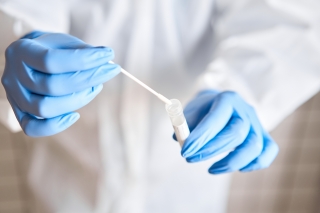Improving Diagnostics for SARS-CoV-2 Together
In time of crisis, partnering up is often a way to quickly come to results. During the start of the pandemic, Bart Keijser, Principal Investigator at TNO, worked together with public an private parties to develop a simple and fast diagnostic method for SARS-CoV-2.
The Dutch are known for their open and welcoming attitude to collaboration and knowledge exchange. Collaboration between public and private parties has been pivotal for reducing the societal and economic impact of the COVID-19 crisis. More than ever, people were motivated to join forces and find a solution for this global challenge, says Bart Keijser. In our project “improved diagnostics for SARS-CoV-2 (ID4Corona)” the individual interests of the partners moved to the background. Each partner proved very willing to consider how their strengths could improve the diagnostic process for SARS-CoV-2.
Efficient and large-scale testing
Many factors challenge the diagnostic process for SARS-CoV-2, including shortages in reagents and consumables. Furthermore, the infrastructure for medical diagnostic testing has been established to perform multiple, symptom-based diagnostic tests for a single patient's benefit and not to offer a single test for large groups of individuals. Keijser: ‘With a variety of partners, from knowledge institutions to companies and from manufacturers to suppliers, ID4Corona aims to realise efficient and large-scale testing in society by resolving the main bottlenecks in the current detection procedure.’
‘One way is to combine the sampling and pre-processing of the virus in one step’, explains Keijser. ‘To detect the virus, its RNA must be sampled. However, the RNA is hidden within a thin lipid shell. By chemically altering the cellulose of the cotton swab or absorbent paper, the virus will not only stick to the swab, but will also open and release its RNA without having to be further processed. This new sampling and pre-processing method will then be linked to the isothermal amplification and detection assay (LAMP method). For PCR testing, you need heating cycles to amplify the RNA and make it visible.
However, the LAMP method is based on a different procedure and use of different enzymes that operate at a single temperature. At a steady 65 degrees, the genetic material is amplified through the LAMP methodology and can be detected in less time and without the use of PCR machines that are scarce during the pandemic. We also aim to develop a Point-of-Care testing platform, combining cellulose-based virus capturing and extraction with the isothermal detection assay. In a set-up not requiring electricity, LAMP based amplification can performed. Via a colour change that occurs due to a change in acidity, the virus can be detected at a glance. That will allow molecular tests to be performed outside of a laboratory infrastructure.’
Global solution
With this PPP project, Keijser not only wants to make a societal impact but an economic impact too. Keijser: ‘It is important that Dutch companies can actively participate in finding a solution. The Netherlands has a lot of expertise and human capital that should not go unused.
It is important to boost this innovative activity to solve the current problems in the Netherlands and to subsequently translate this knowledge so that a global solution can be found.’
This interview is also published in Year in Preview 2021, which is filled with the most important developments in the Dutch Life Sciences & Health sector and provides a glimpse of what’s on the map for 2021. Read the Year in Preview here!

